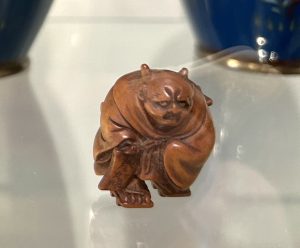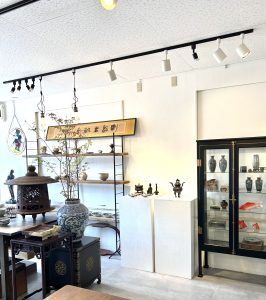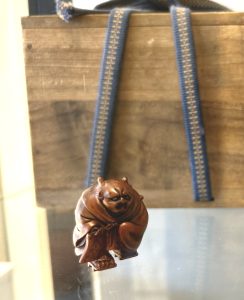大津絵、鬼の寒念仏とは(愛知県名古屋市千種区姫池通 骨董買取 古美術風光舎)
2023.10.11
皆さまこんにちは。スタッフHでございます。
寒暖差の激しい今日この頃、くれぐれも体に気を付けてお過ごしください。
さて、こちらの小さな「根付」。上目遣いの目にぞくっとし、いつも目を逸らせていましたが、手に何を持っているのか不思議に思いじっくり眺めてみました。
持っているものは「奉加帳」(お寺への寄進者名簿)で、この鬼は「大津絵」の画題の一つ「鬼の寒念仏」を表しているようです。
大津絵とは江戸時代初期に東海道の大津追分あたりで、行き交う旅人や巡礼者を相手に、職人たちが荷物にならない土産物として売った民衆絵画です。
ユーモラスな絵の中に、多くの示唆を含んだ大津絵は、浮世絵と並ぶ江戸時代の二大民画といわれ、パブロ・ピカソのコレクションからも見つかっているそうです。
初めは礼拝用の仏画として売り出されましたが、次第に世俗画や戯画が増え、多くは風刺画の要素が強くなっていきました。120以上ある画題の中で鬼が多く登場し、大津絵に登場する鬼は剽軽で愛らしく、人間臭い滑稽な様相を呈し、人の愚かさや邪悪さを象徴した存在ともいわれています。
中でも「鬼の寒念仏」は、僧衣を着た鬼がお寺の再建のため募金活動をする姿を、無慈悲な者が形だけの善行を積む偽善の風刺として扱われています。
顔かたちは鬼のままで、衣装・小道具だけを僧侶にしても無駄だということらしいです。
恐ろしい鬼が、念仏を唱えて布施を乞いながら歩く姿のギャップが好評を博し、人気の画題となりました。通常鬼は胸に鉦(かね)を掛け、左手に寺の再建奉加帳、右手に撞木を持ち、片方の角が折れている姿で描かれています。
片方の角が折れているのは「我」を折って改心したことを表すと捉え、幾分の救いを示しているのだとか。こちらの根付の鬼もよく見ると片方の角が短いですね。

背中を丸めているせいか悲哀も感じさせます。
この丸みは服に引っかからないように角を丸める「根付」の特性だと理解していても、悪者にされて少し可哀想にも思えてきます。
根付はポケットのない和装の時代、小物などを持ち歩く際に使われてきました。巾着や印籠箱などの紐に取り付け、帯の下から上へ挟み込み、根付を帯の上から出すことで巾着などが落ちないような仕掛けとなっています。
根付の歴史は古く江戸時代にはすでに広く親しまれていました。やがて彫刻や絵などが施されていくうちに、職人たちが技術を競い、ついには「根付師」という職業も生まれるほど価値が高まりました。
その美しさと高い技術力から海外では日本のアートとして評価され、「Netsuke」として親しまれています。身に着ける道具であることから触って楽しむうちに「なれ」と呼ばれるまろやかな手触りが生まれ、更に価値を高めているそうです。
根付も大津絵と同じく単純な写実ではなく、伝説やことわざ、縁起物や魔除けになる図を表現しています。得体が知れないからと目を逸らしている場合ではありませんでした。不誠実を戒める教訓としてしっかり受け止めたいと思います。

それでは、またお会いしましょう。
Hello everyone. This is Staff H.
Please take care of yourself in these days of extreme temperature differences.
By the way, here is a small “netsuke”. I always looked away from it, but then I wondered what it was holding in its hand, so I took a closer look at it.
What he was holding was a “fukajo” (a list of donors to a temple), and this demon seemed to represent “Oni no kanenbutsu,” one of the subjects of “Otsu-e” (Otsu paintings).
Otsu-e were folk paintings sold by artisans in the Otsu Oiwake area of the Tokaido Highway in the early Edo period as souvenirs that would not be carried as luggage by travelers and pilgrims.
Otsu-e, which contain many suggestions in their humorous pictures, are said to be one of the two major folk paintings of the Edo period, along with ukiyoe, and have been found in the collection of Pablo Picasso.
Among the more than 120 subjects, ogres are frequently featured, and the ogres in Otsu-e are said to symbolize the foolishness and wickedness of human beings, with their wry, adorable, and humorously human-like appearance. They are also said to symbolize the foolishness and wickedness of human beings.
In “Oni no kanenbutsu” (Oni’s cold prayer), an ogre dressed in priest’s robes is seen raising funds to rebuild a temple, a satire of the hypocrisy of the heartless doing only token good deeds.
It is said that it is futile to dress up the ogre in monk’s clothes and props while keeping his face as an ogre.
The gap between the frightening ogre walking around chanting Buddhist prayers and begging for offerings was well received and became a popular subject for painting. Oni are usually depicted with a gong hanging from their chest, a temple rebuilding votive book in their left hand, and a wooden bell in their right hand, and one of their horns is broken.
The fact that one of its horns is broken is thought to indicate that the demon has reformed by breaking its “self” and thus shows some measure of salvation. If you look closely at this netsuke demon, you will see that one of its horns is also short.
The rounded back gives it a sense of sadness.
Even though I understand that this roundness is a characteristic of netsuke, which have rounded corners to prevent them from getting caught on clothes, I feel a little sorry for them because they are made to look bad.
Netsuke were used to carry small items in the era of kimono without pockets. Attached to the strings of a kinchaku or inro box, the netsuke was inserted from the bottom of the obi to the top, and then pulled out from the top of the obi to prevent the kinchaku or other items from falling off.
Netsuke have a long history and were already widely popular in the Edo period. As netsuke were carved and painted, craftsmen competed in their skills, and eventually their value grew to the point that the profession of “netsuke maker” was born.
The beauty and high level of skill of netsuke craftsmen made them highly regarded overseas as Japanese art, and they are now known as “netsuke. Since netsuke are tools to be worn, they develop a mellow texture called “nare” as they are touched and enjoyed, further increasing their value.
Netsuke, like Otsu-e, are not simply realistic, but depict legends, proverbs, good luck charms, and charms to ward off evil spirits. This was not the time to look away because of its mysteriousness. I would like to take this as a lesson against dishonesty.
So, I will see you again.
*******************
ご実家の整理やお片付けなどをされている方のご相談などが多くございます。
お片付けなどくれぐれもご無理のないようになさってくださいませ。
風光舎では古美術品や骨董品の他にも絵画や宝石、趣味のお品など様々なジャンルのものを買受しております。
お片付けをされていて、こういうものでもいいのかしらと迷われているものでも、どうぞお気軽にご相談下さいませ。
また風光舎は、出張買取も強化しております。ご近所はもちろん、愛知県内、岐阜県、三重県その他の県へも出張いたします。
まずは、お電話お待ちしております。
愛知県名古屋市千種区姫池通
骨董 買取【古美術 風光舎 名古屋店】
TEL052(734)8444
10:00-17:00 OPEN
#出張買取#骨董#古美術#骨董品#絵画#版画#茶道具#刀剣#彫刻


